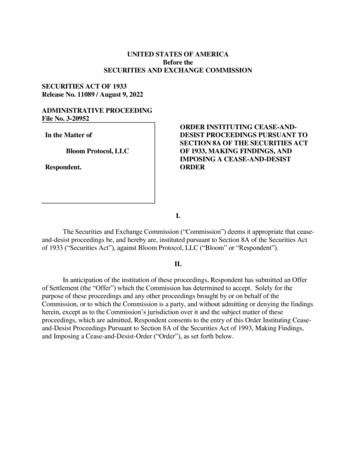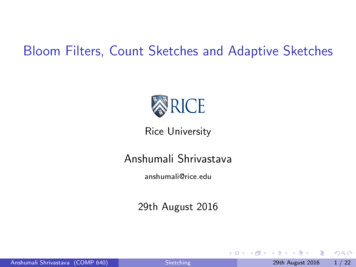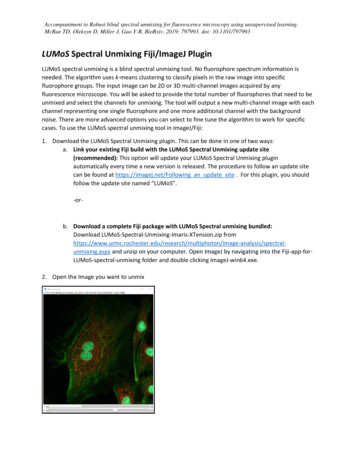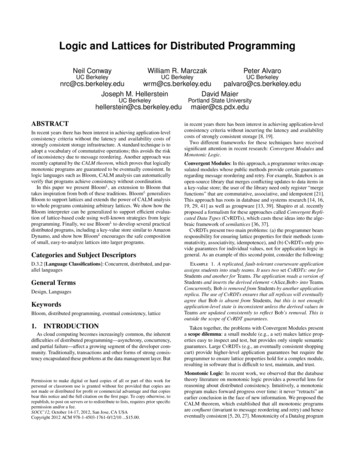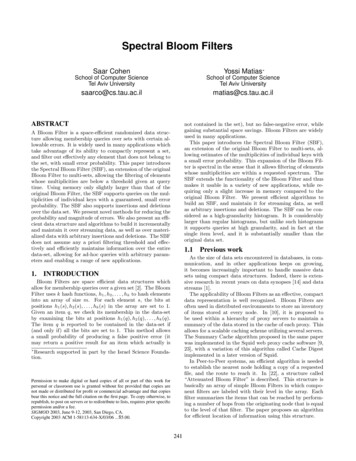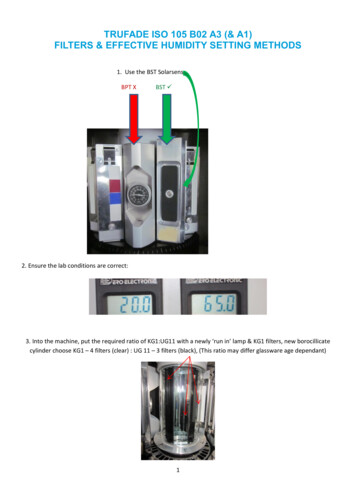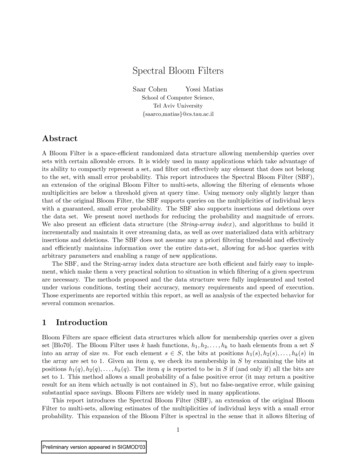
Transcription
Spectral Bloom FiltersSaar CohenYossi MatiasSchool of Computer Science,Tel Aviv University{saarco,matias}@cs.tau.ac.ilAbstractA Bloom Filter is a space-efficient randomized data structure allowing membership queries oversets with certain allowable errors. It is widely used in many applications which take advantage ofits ability to compactly represent a set, and filter out effectively any element that does not belongto the set, with small error probability. This report introduces the Spectral Bloom Filter (SBF),an extension of the original Bloom Filter to multi-sets, allowing the filtering of elements whosemultiplicities are below a threshold given at query time. Using memory only slightly larger thanthat of the original Bloom Filter, the SBF supports queries on the multiplicities of individual keyswith a guaranteed, small error probability. The SBF also supports insertions and deletions overthe data set. We present novel methods for reducing the probability and magnitude of errors.We also present an efficient data structure (the String-array index ), and algorithms to build itincrementally and maintain it over streaming data, as well as over materialized data with arbitraryinsertions and deletions. The SBF does not assume any a priori filtering threshold and effectivelyand efficiently maintains information over the entire data-set, allowing for ad-hoc queries witharbitrary parameters and enabling a range of new applications.The SBF, and the String-array index data structure are both efficient and fairly easy to implement, which make them a very practical solution to situation in which filtering of a given spectrumare necessary. The methods proposed and the data structure were fully implemented and testedunder various conditions, testing their accuracy, memory requirements and speed of execution.Those experiments are reported within this report, as well as analysis of the expected behavior forseveral common scenarios.1IntroductionBloom Filters are space efficient data structures which allow for membership queries over a givenset [Blo70]. The Bloom Filter uses k hash functions, h1 , h2 , . . . , hk to hash elements from a set Sinto an array of size m. For each element s S, the bits at positions h1 (s), h2 (s), . . . , hk (s) inthe array are set to 1. Given an item q, we check its membership in S by examining the bits atpositions h1 (q), h2 (q), . . . , hk (q). The item q is reported to be in S if (and only if) all the bits areset to 1. This method allows a small probability of a false positive error (it may return a positiveresult for an item which actually is not contained in S), but no false-negative error, while gainingsubstantial space savings. Bloom Filters are widely used in many applications.This report introduces the Spectral Bloom Filter (SBF), an extension of the original BloomFilter to multi-sets, allowing estimates of the multiplicities of individual keys with a small errorprobability. This expansion of the Bloom Filter is spectral in the sense that it allows filtering of1Preliminary version appeared in SIGMOD'03
elements whose multiplicities are within a requested spectrum. The SBF extends the functionalityof the Bloom Filter and thus makes it usable in a variety of new applications, while requiring onlya slight increase in memory compared to the original Bloom Filter. We present efficient algorithmsto build an SBF, and maintain it for streaming data, as well as arbitrary insertions and deletions.The SBF can be considered as a high-granularity histogram. It is considerably larger than regularhistograms, but unlike such histograms it supports queries at high granularity, and in fact at thesingle item level, and it is substantially smaller than the original data set.Unlike the standard Bloom Filter, which uses a straight-forward approach to storage (a bitvector), the SBF is by nature more complex. Since counters have to be stored in an economicalfashion, a major consideration is the ability to hold, update and access the information in an efficientand compact manner. To do so, this report presents the String-Array Index data structure, fulfillingthese requirements. We also propose and analyze methods for querying the SBF, improving overthe standard lookup scheme and reducing the error probability and size.1.1Previous workAs the size of data sets encountered in databases, in communication, and in other applicationskeeps on growing, it becomes increasingly important to handle massive data sets using compactdata structures. Indeed, there is extensive research in recent years on data synopses [GM99] anddata streams [AMS99, BBD 02].The applicability of Bloom Filters as an effective, compact data representation is well recognized. In this section, we briefly survey several major applications of Bloom Filters. These usesinclude peer-to-peer systems, distributed calculations and distributed database queries and otherapplications. Several modifications have also been published over the basic Bloom Filter structure,optimizing the performance and storage for different scenarios.1.1.1Distributed processingBloom Filters are often used in distributed environments to store an inventory of items storedat every node. In [FCAB98], Bloom Filters are proposed to be used within a hierarchy of proxyservers to maintain a summary of the data stored in the cache of each proxy. This allows for ascalable caching scheme utilizing several servers. The Summary Cache algorithm proposed in thesame paper was implemented in the Squid web proxy cache software [FCA, Squ], with a variationof this algorithm called Cache Digest implemented in a later version of Squid. In this scenario, theBloom Filters are exchanged between nodes, creating an efficient method of representing the fullpicture of the items stored in every proxy among all proxies.In peer-to-peer systems, an efficient algorithm is needed to establish the nearest node holdinga copy of a requested file, and the route to reach it. In [RK02], a structure called “AttenuatedBloom Filter” is described. This structure is basically an array of simple Bloom Filters in whichcomponent filters are labeled with their level in the array. Each filter summarizes the items thatcan be reached by performing a number of hops from the originating node that is equal to thelevel of that filter. The paper proposes an algorithm for efficient location of information using thisstructure. The main difference between this method and the Summary Cache algorithm is that inthis article, the notion of distance and route between nodes is taken into consideration, while in[FCAB98], every remote node reachable (and whose data is maintained) in every node is consideredto be within the same distance from the originating node.A different aspect of distributed processing is distributed database systems. In such system,the data is partitioned and stored in several locations. Usually, the scenario in question involves2
several relations which reside on different locations, and a query that requires a join between thoserelations. The use of Bloom Filters was proposed in handling such joins. Bloomjoin is a scheme forperforming distributed joins [ML86], in which a join between relations R and S over the attributeX is handled by building a Bloom Filter over R.X and transmitting it to S. This Bloom Filter isused to filter tuples in S which will not contribute to the join result, and the remaining tuples aresent back to R for completion of the join. The compactness of the Bloom Filter together with theability to perform strong filtering of the results during the execution of the query saves significanttransmission size while not sacrificing accuracy (as the results can be verified by checking themagainst the real data).1.1.2Filtering and validationBloom Filters were proposed in order to improve performance of working with Differential Files[Gre82]. A differential file stores changes in a database until they are executed as a batch, thudreducing overheads caused by sporadic updates and deletions to large tables. However, when using adifferential file, its contents must be taken into account when performing queries over the database,with as little overhead as possible. A Bloom Filter is used to identify data items which have entrieswithin the differential file, thus saving unnecessary access to the differential file itself. Since everyquery and update must consider the contents of the differential file, having an efficient method toprevent unnecessary file probes improves performance dramatically.Another area in which Bloom Filters can be used is checking validity of proposed passwords[MW94] against previous passwords used and a dictionary. This method can quickly and efficientlyprevent users from reusing old passwords or using dictionary words. Recently, Broder et al [Bro02]used Bloom Filters in conjunction with hot list techniques presented in [GM98] to efficiently identifypopular search queries in the Alta-Vista search engine.1.1.3Extensions and improvementsSeveral improvements have been proposed over the original Bloom Filter. Note that in manydistributed applications (such as in Summary Cache [FCAB98]), the Bloom Filters are used ratheras a message within the system, sent from one node to the other when exchanging information. In[Mit01] the data structure was optimized with respect to its compressed size, rather than its normalsize, to allow for efficient transmission of the Bloom Filter between servers. It is easily shown thata Bloom Filter that is space-optimized is characterized by its bit vector being completely random(see Section 2.1), which makes compression inefficient and at times useless. The article shows thatby maintaining a locally larger Bloom Filter, it is possible to achieve a compressed version of thebit array which is more efficient.A modification proposed in [MW94] is imposing a locality restriction on the hash functions,to allow for faster performance when using external storage. This improvement tends to localizequeries to consecutive blocks of storage, allowing less disk accesses and faster performance whenusing slow secondary storage. In [FCAB98] a counter has been attached to each bit in the arrayto count the number of items mapped to that location. This provides the means to allow deletionsin a set, but still does not support multi-sets. To maintain the compactness of the structure, thesecounters were limited to 4 bits, which is shown statistically to be enough to encode the numberof items mapped to the same location, based on the maximum occupancy in a probabilistic urnmodel, even for very large sets. However this approach is not adequate when trying to encode thefrequencies of items within multi-sets, in which items may easily appear hundreds and thousandsof times.3
1.1.4Iceberg queries and streaming dataThe concept of multiple hashing (while not precisely in the form of Bloom Filters) was used inseveral recent works, such as supporting iceberg queries [FSGM 98] and tracking large flows innetwork traffic [EV02]. Both handle queries which correspond to a very small subset of the data(the “tip of the iceberg”) defined by a threshold, while having to efficiently explore the entire data.These implementations assume a prior knowledge of the threshold and avoid maintaining a synopsisover the full data set. One of the major differences between the articles is that the former assumesthe data is available for queries and scanning, while the latter assume a situation of streaming data,in which the information is available only once, as it arrives, and cannot be queried afterwards.This situation is very common in network applications, where huge amounts of data flow rapidlyand need to be handled as it passes. Usually it is not possible to store the entire data as it flows, andtherefore it is not possible to perform retroactive queries over it. A recent survey describes severalapplications and extensions of the Bloom Filter, with emphasis on network applications [BM02].Current implementations of Bloom Filters do not address the issue of deletions over multi-sets.An insert-only approach is not enough when using widely used data warehouse techniques, such asmaintaining a sliding window over the data. In this method, while new data is inserted into thedata structure, the oldest data is constantly removed. When tracking streaming data, often wewould be interested in the data that arrived in the last hour or day, for example. In this report weshow that the SBF provides this functionality as a built-in ability, under the assumption that thedata leaving the sliding window is available for deletion, while allowing (approximate) membershipand multiplicity queries for individual items. An earlier version of this work appears in [Mat].1.1.5Succinct data structuresThe Bloom Filter is an instance of a succinct data structure that addresses membership queriesover a data set, while being as compact and efficient as possible. In this sense, the Bloom Filter isa synopsis data structure, which aims to solve a given problem while emphasizing on compactness.The literature contains a broad selection of such data structures which address common problems.Within this work, we define and address the variable length access problem which can be easilyreduced to the select problem. The select problem deals with building a data structure over a bitvector V such that for an index i, it returns the index within V of the ith 1 bit.Known solutions to the select problem allow O(1) time lookups using o(N ) bits of space [Jac89,Mun96]. However, these solutions handle the static case, in which the underlying bit vector doesnot change during the lifespan of the data structure. In the general case, this is an adequatesolution to the access problem we are facing, but it fails to meet the demands for updates, whichare mandatory for our implementation of the SBF. Solutions which support updates use the sameamount of space, and given a parameter b log N/ log log N , support select in O(logb N ) time, andupdate in amortized O(b) time [RRR00]. Specifically, select can be supported in constant time ifupdate is allowed to take O(N ² ) amortized time, for ² 0.It should be noted that the solutions given to the select problem are rather complicated andare difficult to implement, as pointed out in [Jac89]. In Section 4 we present our solution for thevariable length access problem, consisting of a novel data structure - the String-Array Index. Thisstructure is a fairly simple structure and arguably practical, as demonstrated in our implementationand the experiments conducted during this work. We also present a method to support updates,which appears to be practical in the context of current methods as well.4
1.2ContributionsThis report presents the Spectral Bloom Filter (SBF), a synopsis which represents multisets thatmay change dynamically in a compact and efficient manner. Queries regarding the multiplicitiesof individual items can be answered with high accuracy and confidence, allowing a range of newapplications. The main contributions of this report are: The Spectral Bloom Filter synopsis, which provides a compact representation of data setswhile supporting queries on the multiplicities of individual items. For a multiset S consistingof n distinct elements from U with multiplicitiesP {fx : x S}, an SBF of N o(N ) O(n)bits can be built in O(N ) time, where N k x S dlog fx e. For any given q U , the SBFprovides in O(1) time an estimate fˆq , so that fˆq fq , and an estimate error (fˆq 6 fq ) occurswith low probability (exponentially small in k). This allows effective filtering of elementswhose multiplicities in the data set are below a threshold given at query time, with a smallfraction of false positives, and no false negatives. The SBF can be maintained in O(1) expectedamortized time for inserts, updates and deletions, and can be effectively built incrementallyfor streaming data. We present experiments testing various aspects of the SBF structure. We show how the SBF can be used to enable new applications and extend and improve existingapplications. Performing ad-hoc iceberg queries is an example where one performs a queryexpected to return only a small fraction of the data, depending on a threshold given only atquery time. Another application is spectral Bloomjoins, where the SBF reduces the numberof communication rounds among remote database sites when performing joins, decreasingcomplexity and network usage. It can also be used to provide a fast aggregative index overan attribute, which can be used in algorithms such as bifocal sampling.The following novel approaches and algorithms are used within the SBF structure: We show two algorithms for SBF maintenance and lookup, which result with substantiallyimproved lookup accuracy. The first, Minimal Increase, is simple, efficient and has very lowerror rates. However, it is only suitable for handling inserts. This technique was independentlyproposed in [EV02] for handling streaming data. The second method, Recurring Minimum,also improves error rates dramatically while supporting the full insert, delete and updatecapabilities. Experiments show favorable accuracy for both algorithms. For a sequence ofinsertions only, both Recurring Minimum and Minimal Increase significantly improve over thebasic algorithm, with advantage for Minimal Increase. For sequences that include deletions,Recurring Minimum is significantly better than the other algorithms. One of the challenges in having a compact representation of the SBF is to allow effectivelookup into the i’th string in an array of variable length strings (representing counters in theSBF). We address this challenge by presenting the string-array index data structure which isof independent interest. For a string-array of m strings with an overall length of N bits, astring-array index of o(N ) O(m) bits can be built in O(m) time, and support access to anyrequested string in O(1) time.1.3Report outlineThe rest of this report is structured as follows. In Section 2 we describe the basic ideas of theSpectral Bloom Filter as an extension of the Bloom Filter. In Section 3, we describe two heuristicswhich improve the performance of the SBF with regards to error ratio and size. Section 4 deals5
with the problem of efficiently encoding the data in the SBF, and presents the string-array indexdata structure which provides fast access while maintaining the compactness of the data structure.Section 5 presents several applications which use the SBF. Experimental results are presented inSection 6, followed by our conclusions.2Spectral Bloom FiltersThis section reviews the Bloom Filter structure, as proposed by Bloom in [Blo70]. We present thebasic implementation of the Spectral Bloom Filter which relies on this structure, and present theMinimum Selection method for querying the SBF. We briefly discuss the way the SBF deals withinsertions, deletions, updates and sliding window scenarios.2.1The Bloom FilterA Bloom Filter is a method for representing a set S {s1 , s2 , . . . , sn } of keys from a universe U ,by using a bit-vector V of m O(n) bits. It was invented by Burton Bloom in 1970 [Blo70].All the bits in the vector V are initially set to 0. The Bloom Filter uses k hash functions,h1 , h2 , . . . , hk mapping keys from U to the range {1 . . . m}. For each element in s S, the bits atpositions h1 (s), h2 (s), . . . , hk (s) in V are set to 1. Given an item q U , we check its membership inS by examining the bits at positions h1 (q), h2 (q), . . . , hk (q). If one (or more) of the bits is equal to0, then q is certainly not in S. Otherwise, we report that q is in S, but there may be false positiveerror: the bits hi (q) may be all equal to one even though q 6 S, if other keys from S were mappedinto these positions. We denote such an occurrence bloom error, and denote its probability Eb .The probability for a false positive error is dependent on the selection of the parameters m, k.After the insertion of n keys at random to the array of size m, the probability that a particular bitis 0 is exactly (1 1/m)kn . Hence the probability for a bloom error in this situation is¶ !k ³µ k1 kn 1 e kn/m .1 1 mÃEb kThe right-hand expression is minimized for k ln(2) · ( mn ), in which case the error rate is (1/2) m/n(0.6185). Thus, the Bloom Filter is highly effective even for m cn using a small constant c.For c 8, for example, the false positive error rate is slightly larger than 2%. Let γ nk/m; i.e, γis the ratio between the number of items hashed into the filter and the number of bits. Note thatin the optimal case, γ ln(2) 0.7.2.2The Spectral Bloom FilterThe Spectral Bloom Filter (SBF) replaces the bit vector V with a vector of m counters, C. Thecounters in C roughly represent multiplicities of items, all the counters in C are initially set to 0. Inthe basic implementation, when inserting an item s, we increase the counters Ch1 (s) , Ch2 (s) , . . . , Chk (s)by 1. The SBF stores the frequency of each item, and it also allows for deletions, by decreasingthe same counters. Consequently, updates are also allowed (by performing a delete and then aninsert).6
SBF basic construction and maintenanceLet S be a multi-set of keys taken from a universe U . For x U let fx be the frequency of x in S.Letvx {Ch1 (x) , Ch2 (x) . . . , Chk (x) }be the sequence of values stored in the k counters representing x’s value, and v̂x {v̂x1 , v̂x2 . . . , v̂xk }be a sequence consisting of the same items of vx , sorted in non-decreasing order; i.e. mx v̂x1 isthe minimal value observed in those k counters.To add a new item x U to the SBF, the counters {Ch1 (x) , Ch2 (x) . . . , Chk (x) } are increased by1. The Spectral Bloom Filter for a multi-set S can be computed by repeatedly inserting all theitems from S. The same logic is applied when dealing with streaming data. While the data flows,it is hashed into the SBF by a series of insertions.Querying the SBFA basic query to the SBF on an item x U returns an estimate on fx . We define the SBF error,denoted ESBF , to be the probability that for an arbitrary element z (not necessarily a member ofS), fˆz 6 fz . The basic estimator, denoted as the Minimum Selection (MS) estimator is fˆx mx .Claim 1. For all x U , fx mx . Furthermore, fx 6 mx with probability ESBF Eb ¡ k1 e kn/m .Proof. Since for each insertion of x, all its counters are increased, then it is clear that mx fx .The case of inequality is exactly the situation of a Bloom Error as defined for the simple BloomFilter, where all counters are stepped over by other items hashing to the same positions in thearray, and therefore has the same probability Eb .The above claim shows that the error of the estimator is one-sided, and that the probabilityof error is the bloom error. Hence, when testing whether fx 0 for an item x U , we obtainidentical functionality to that of a simple Bloom Filter. However, an SBF enables more generaltests of fx T for an arbitrary threshold T 0, for which possible errors are only false-positives.For any such query the error probability is ESBF .Deletions and sliding window maintenanceDeleting an item x U from the SBF is achieved simply by reversing the actions taken for insertingx, namely decreasing by 1 the counters {Ch1 (x) , Ch2 (x) . . . , Chk (x) }. In sliding windows scenarios, incases data within the current window is available (as is the case in data warehouse applications),the sliding window can be maintained simply by preforming deletions of the out-of-date data.Distributed processingThe SBF is easily extended to distributed environment. It allows simple and fast union of multi-sets,for example when a query is required over several sets. This happens frequently in distributed database systems, where a single relation is partitioned to several sites, each containing a fraction of theentire data-set. A query directed at this relation will require processing of the data stored withineach site, and then merging the results into a final answer. When such a query is required uponthe entire collection of sets, SBFs can be united simply by addition of their counter vectors. Thisproperty can be useful for partitioning a relation into several tables covering parts of the relation.Other features of the SBF relevant to distributed execution of joins are presented in Section 5.3.7
Queries over joins of setsApplications which allow for joins of sets, such as Bloomjoins (see Section 5.3), can be implemented efficiently by multiplying SBF. The multiplication requires the SBF to be identical in theirparameters and hash functions. The counter vectors are linearly multiplied to generate an SBFrepresenting the join of the two relations. The number of distinct items in a join is bounded bythe maximal number of distinct items in the relations, resulting in an SBF with fewer values, andhence better accuracy.External memory SBFWhile Bloom Filters are relatively compact, they may still be too large to fit in main memory.However, their random nature prevents them from being readily adapted to external memoryusage because of the multiple (up to k) external memory accesses required for a single lookup. In[MW94], a multi-level hashing scheme was proposed for Bloom filters, in which a first hash functionhashes each value to a specific block, and the hash functions of the Bloom Filter hash within thatblock. The analysis in [MW94] showed that the accuracy of the Bloom Filter is affected by thesegmentation of the available hashing domain, but for large enough segments, the difference isnegligible. The same analysis applies in the SBF case, since the basic mechanism remains thesame.SBF implementationThere are several issues which are particular to the SBF and need to be resolved for this datastructure. The first issue is maintaining the array of counters, where we must consider the totalsize of the array, along with the computational complexity of random access, inserts and deletionsfrom the array. The other is query performance, with respect to two error metrics: the error rate(similar to the original Bloom Filter), and the size of the error.2.3Minimum Selection error analysis for Zipfian DistributionUsing the MS algorithm yields an error with probability of Eb (1 e γ )k . For membershipqueries, this provides a full description of the error, since its size is fixed. However, when answeringcount-estimate queries, we need to address the issue of the size of the error in the estimate, andprovide an estimate to this quantity. We cannot provide such an estimate for arbitrary data set,since the size of the error is directly dependent on the distribution of the data inserted into theSBF. An item with a very small frequency (or even frequency of 0) might get its counters steppedover by the k most frequent items in the dataset, causing an error whose size is unknown withoutfurther knowledge of the distribution.It is common for real-life data sets to demonstrate a Zipfian distribution [Zip49]. We provideanalytical results regarding the size of the errors by analyzing data which is distributed accordingto Zipf’s law. This is based on the fact that most data-sets can be described by such distribution,using the correct parameters. In a Zipfian distribution, the probability of the ith most frequentitem in the data-set to appear is equal to pi c/iz , with c being some normalization constant,and z is the Zipf parameter, or skew of the data. For data with a total of N items, the expectedfrequency of item i is therefore fi N c/iz . From now on, we assume that the frequencies aresorted in descending order, such that fi is the frequency of the ith most frequent item, and forevery i j we have fi fj .8
The calculations in this section all assume that a situation of Bloom error has occurred. Weonly deal with figuring out the size of the error stemming from that situation. We also assume thatfor the ith item, which is subject to error, each of its k counters is shared with no more than oneother item. This implies that there is no situation where the size of the error is the accumulatingfrequency of two or more items. This assumption is required only for the counter which is subjectto the smallest error, since other counters do not participate in the calculation of the estimatedfrequency of i.The probability for a single counter to be subject to at least two items stepping over it isE 0 1 (1 1/m)N k N k(1/m)(1 1/m)N k 1 , with (1 1/m)N k representing the probabilitythat no item stepped over it, and the second term is the probability that exactly one item stepsγmover it. Some algebraic manipulations transform this probability to E 0 1 e γ (1 m 1). Theprobability that an item is subject to a Bloom error with one counter having two items steppingover it is therefore E 0 · (1 e γ )k 1 , which for γ 0.7 and k 5 yields a probability of less than1%. This is a bound on the actual probability of interest, since in most cases the counter subjectto a double error will not be the minimal counter, because of the accumulating error. Thus, theexpected probability of that event is significantly smaller than the probability for a Bloom error,and therefore we ignore it in the remainder of this discussion.We state the following lemma, concerning the distribution of the relative error in Zipfian distribution:Lemma 2. Let S be a multi-set with n distinct items taken at random from a Zipfian distributionof skew z, hashed into a SBF. Let T be a threshold T 0, and let REiz be the relative error forthe ith most frequent item in S, REiz (mi fi )/fi . Given that REi 0, the probability of thisrelative error exceeding T is¶kµizP (REi T ) k(n k)T 1/zProof. We begin our proof by calculating the expected relative error for the ith most frequent itemin the data. First, we note that the error for an item is the fr
same paper was implemented in the Squid web proxy cache software [FCA, Squ], with a variation of this algorithm called Cache Digest implemented in a later version of Squid. In this scenario, the Bloom Filters are exchanged between nodes, creating an efficient method of representing the full picture of the items stored in every proxy among all .

